Water conditioner is a staple in my aquarium kits. The easiest way to ensure your water is aquarium safe.
But they’re not all the same quality when it comes to how much you’ll get for your money.
Sneak peak – the pricier options may be cheaper than you think when you look deeper.
In this guide, I’ll provide you with everything you need to know so you can but the best aquarium water conditioner for you.
Key Takeaways
- The terms water conditioner and dechlorinators are often used interchangeably, but they’re referring to the same thing: Making water aquarium safe.
- If you get water from a municipal supplier, you must use a dechlorinator.
- I highly recommend you check to see water supplies use either chlorine (Cl) or chloramine (NH2Cl)
- If it comes from a private well with no chemicals added, you can go straight into the tank with no dechlorinator.
- Seachem prime is my recommendation because it’ll treat 2500 gallons per 250 ml. Other brands only treat 500 gallons per 250ml and 250 gallons per 250ml.
- I do keep a bottle of Stress Coat around in case a fish gets banged up, but I don’t use it as my regular dechlorinator when I do water changes.
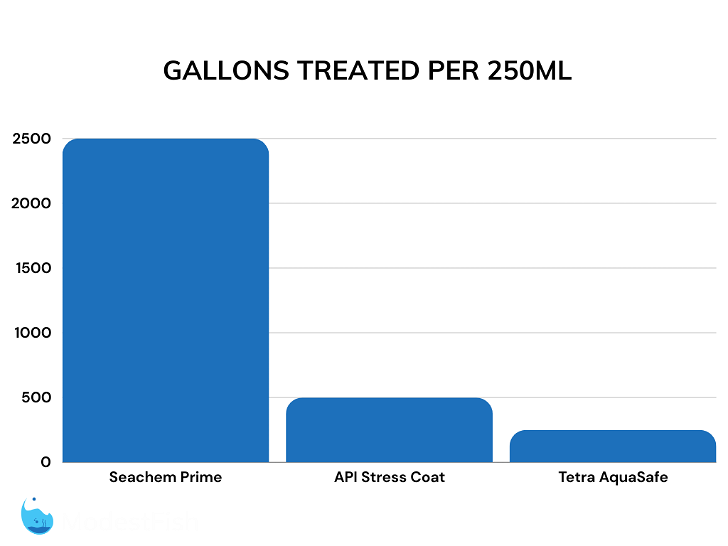

Last update on 2024-04-19 / Commissions Earned / Images from Amazon Product Advertising API
Navigate This Article Quickly
First Check If You Need Water Conditioner
If you are getting your water from a municipal water supply, then you must you a water conditioner.
Water supply companies put chemicals into the water to make sure that it is safe for drinking. These chemicals kill bacteria, and some viruses, which is good, but can also kill fish and invertebrates in your aquarium.
If your water comes from a private well, then no chemicals have been added and it can go straight into your tank.
Chlorine vs Chloramine: Know What’s in Your Water
Alright, alright, alright! Let’s talk about chemistry! Oh don’t groan at me, this is important.
Major water supplies use either chlorine (Cl) or chloramine (NH2Cl).
It’s really important you find out which one your water supply uses. It’s usually pretty simple to do this. I was able to search for this info online for my own water supply company, and was able to find the information in just a matter of minutes.
Straight old school chlorine is fairly simple to get rid of. You can boil the water for a few minutes, or even just let it sit out for a day or two and the chlorine will dissipate on its own.
But, more and more, water supplies are switching to chloramine because it’s much more stable and harder to get out of the water. Chloramine is chlorine that’s bound to ammonia. It does not just dissipate out of water the way chlorine does.
You’d have to boil water for hours to get rid of chloramine, and it won’t dissipate if water is left to sit out.
If your water supply uses chloramine, you will absolutely need to use a chemical water conditioner to remove it.
And, chloramine is chlorine bound by ammonia. If your water conditioner only removes chlorine, and does not detoxify ammonia, you could still be stressing your fish out.
Methods for Conditioning Water
Yes, several in fact, but they don’t all work well on chloramine.
Leaving Water to Sit Out
This method is super simple. You just put tap water into open containers and let it sit out overnight. You can even speed up the process by adding some aeration to the water with an airstone and pump or a small powerhead.
But, this only works to remove chlorine. Chloramine will not just dissipate the way chlorine will.
Boiling Water
Boiling water for over 15 minutes will remove chlorine.
But again, because chloramine does such a great job at sticking around, this method doesn’t work well. You’d have to boil the water for hours to remove chloramine. That’s pretty impractical.
Reverse Osmosis (RO)
RO systems force water through a super fine, semipermeable membrane that lets pure water molecules pass through, but keeps impurities out.
An RO filter will remove both chlorine and chloramine from your water.
But, RO systems are really expensive, waste quite a bit of water, can take up a lot of room, take a long time to filter water and remove good things from the water, like minerals, that fish and invertebrates need.
So, yes, you could dechlorinate your water with an RO system, but it’s really impractical and kind of overkill for just dechlorination.
Chemical Dechlorinators
I would argue that using a chemical dechlorinator is the best way to make tap water safe for fish.
These chemical treatments instantly remove chlorine from the water.
If your water supply utilizes chloramine, I would suggest also getting a dechlorinator that detoxifies ammonia.
If you use just a plain dechlorinator on chloramine, the chlorine goes away, but it leaves the ammonia behind. Ammonia is highly toxic and can easily stress fish.
Which Conditioners Were Examined?
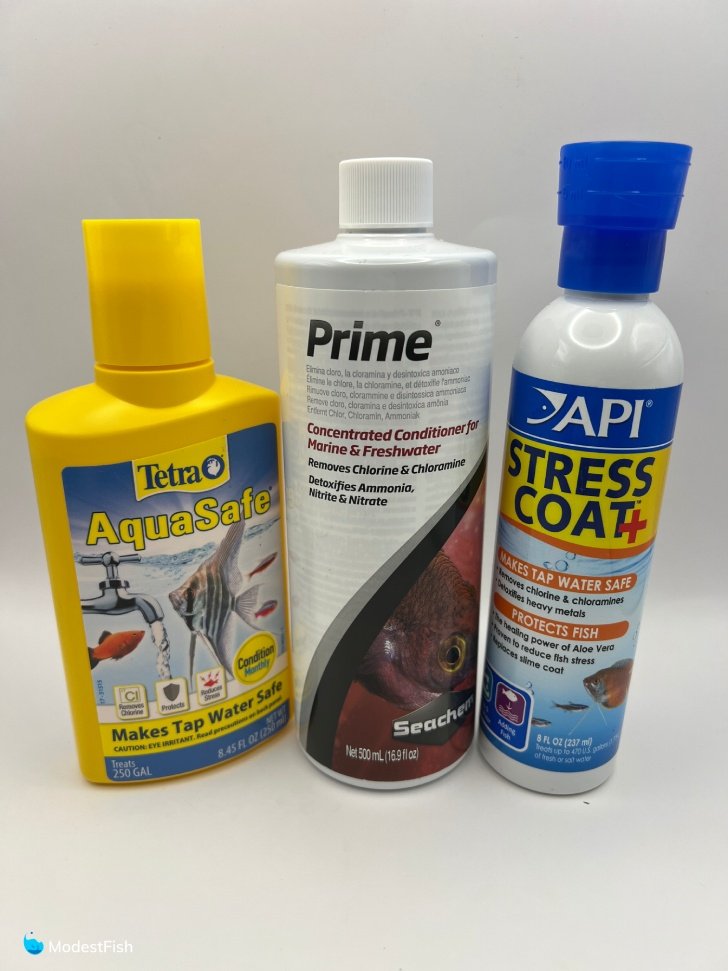
I bought three different dechlorinators:
- Seachem Prime
- API Stress Coat
- Tetra Aquasafe
How I Choose a Dechlorinator
Here’s what I considered when testing these dechlorinators:
- Cost of use – how many gallons of water does the bottle of dechlorinator treat. I want a concentrated dechlorinator so that each bottle treats more gallons of water.
- What it removes or detoxifies from the water – all remove chlorine, and detoxify heavy metals, but some also detoxify other chemicals, like ammonia and nitrate. I personally prefer a product that nullifies as many substances as possible.
- What it adds to the water – some dechlorinator products also contain additives that can increase fish slime coat production, something that is thought to be helpful when fish are injured, sick or stressed. I do think this can be handy to keep on hand in case of emergencies, but I don’t think it’s necessary to have it for every water change.
1. Seachem Prime
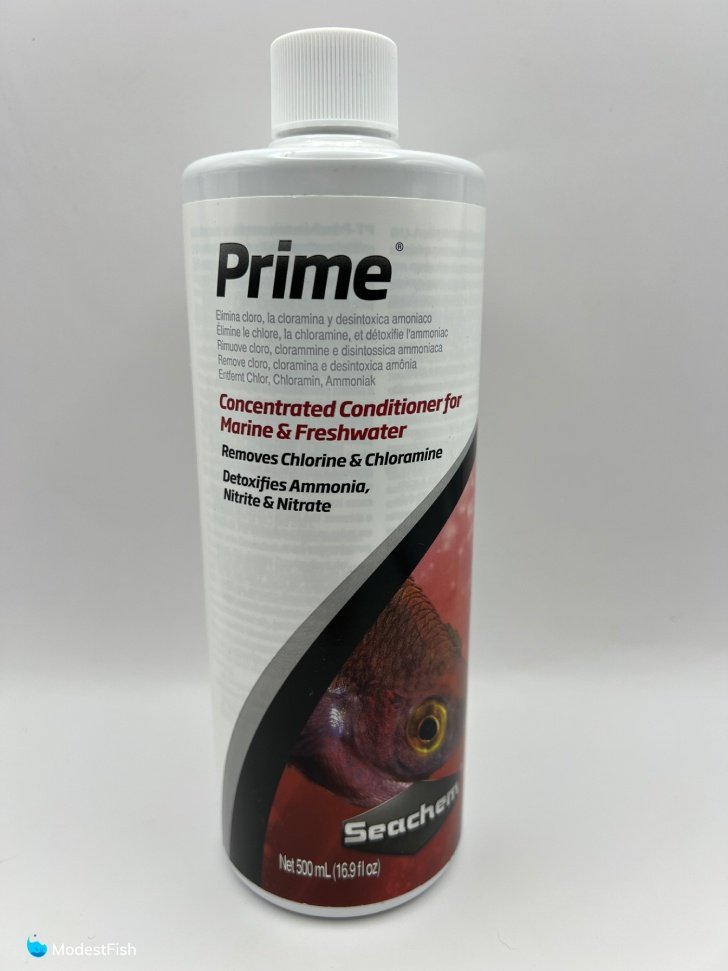
Removes/Detoxifies:
- Chlorine/chloramine
- Heavy metals
- Ammonia
- Nitrite
- Nitrate
Seachem Prime is my number one choice for conditioning tap water. It’s highly concentrated and removes the largest number of contaminants from the water column.
It might cost more to buy a bottle of Prime, but the cost of use is much, much lower for Prime because it is so highly concentrated. Prime is over four times cheaper to use than Stress Coat or Aquasafe.
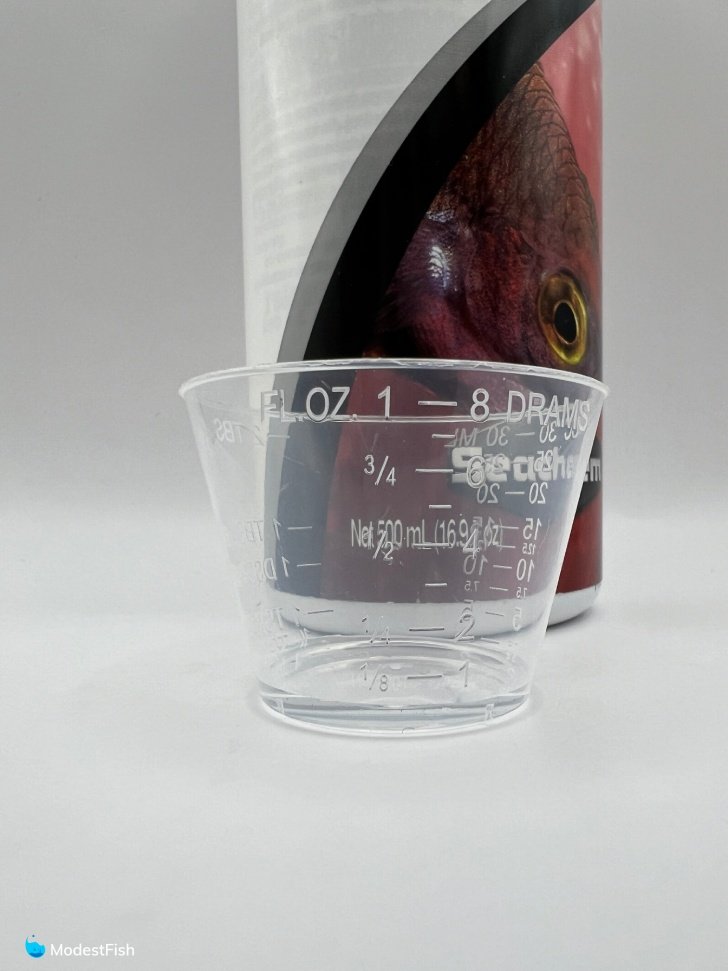
If you buy a 250 milliliter (8.4 ounce) bottle of Prime, it will treat 2,500 gallons (approx. 10,000 liters) of water. The same size bottle of Stress Coat will treat 500 gallons (approx. 2,200 liters) and the same amount of AquaSafe will only treat 250 gallons (approx. 1,100 liters).
What it adds:
Prime does not have any kind of additives for increasing slime coat; it just removes and detoxifies things.

Last update on 2024-04-19 / Commissions Earned / Images from Amazon Product Advertising API
2. API Stress Coat
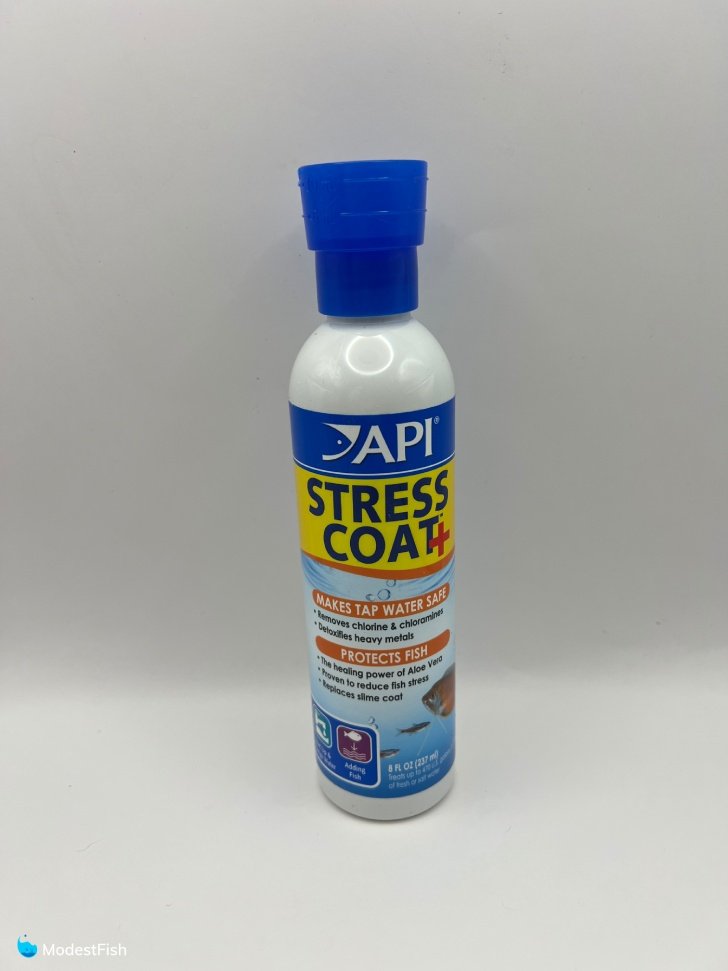
Removes/Detoxifies:
- Chlorine/chloramine
- Heavy metals
API Stress Coat will remove chlorine/chloramine, but it does not detoxify ammonia, nitrate or nitrite the way Prime does.
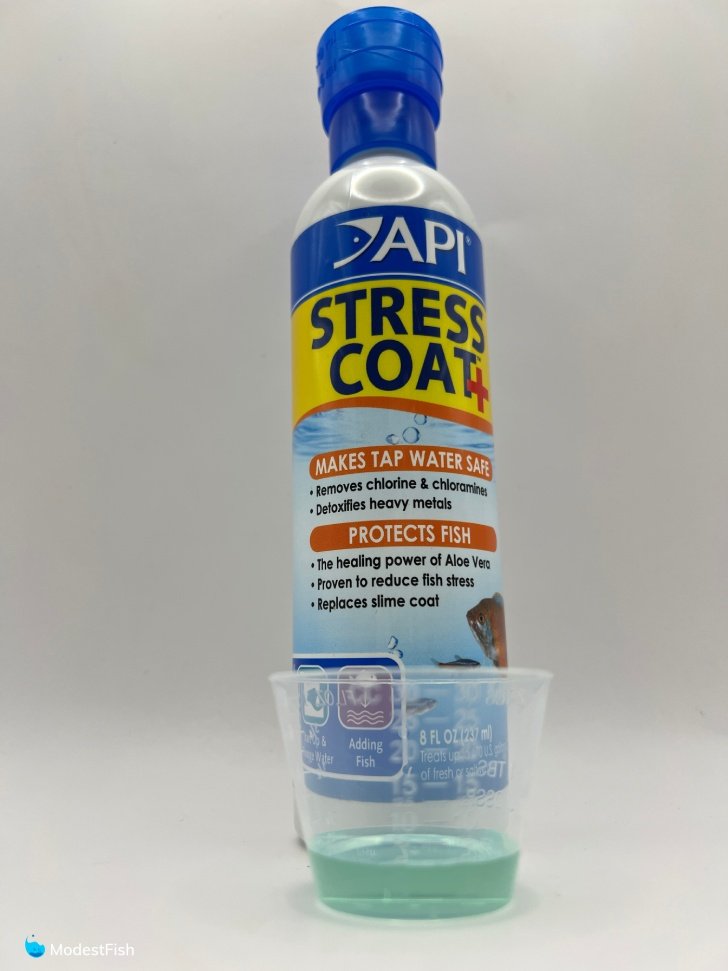
This product is also not as concentrated as Seachem Prime. A 250 milliliter bottle only treats 500 gallons.
So, if you’re looking for the best deal as far as cost of use for dechlorination, this isn’t the one.
What it adds:
API Stress Coat contains aloe vera that can help fish produce extra slime coat.
This is very useful for fish that have been sick or injured because a fish’s slime coat is an important part of their immune system. It creates a physical barrier against germs and the slime itself has antimicrobial properties.
So, if fish have been stressed, beat up or recently transported, adding some Stress Coat to your tank may help them recover.
I don’t think that you need to add something to increase slime coat with every water change, but I do think it’s worth it to keep Stress Coat around in case of emergencies. It has a really long shelf life, so you can just stick it in a drawer so you have it on-hand.

Last update on 2024-04-19 / Commissions Earned / Images from Amazon Product Advertising API
3. Tetra AquaSafe
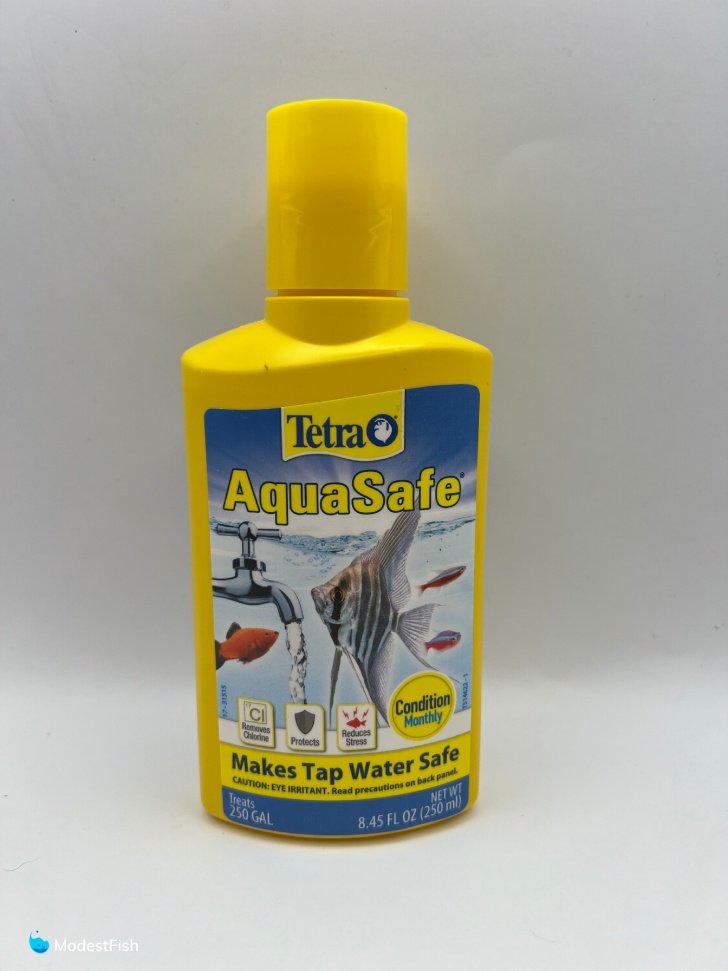
Removes/Detoxifies:
- Chlorine
- Heavy metals
So, don’t get me wrong, I would way rather that someone use this product to at least get the chlorine out of water and make it safe for fish and invertebrates than not dechlorinate their water. It’s just that I don’t think this conditioner is a very good deal, especially since it doesn’t detoxify ammonia, nitrite or nitrate.
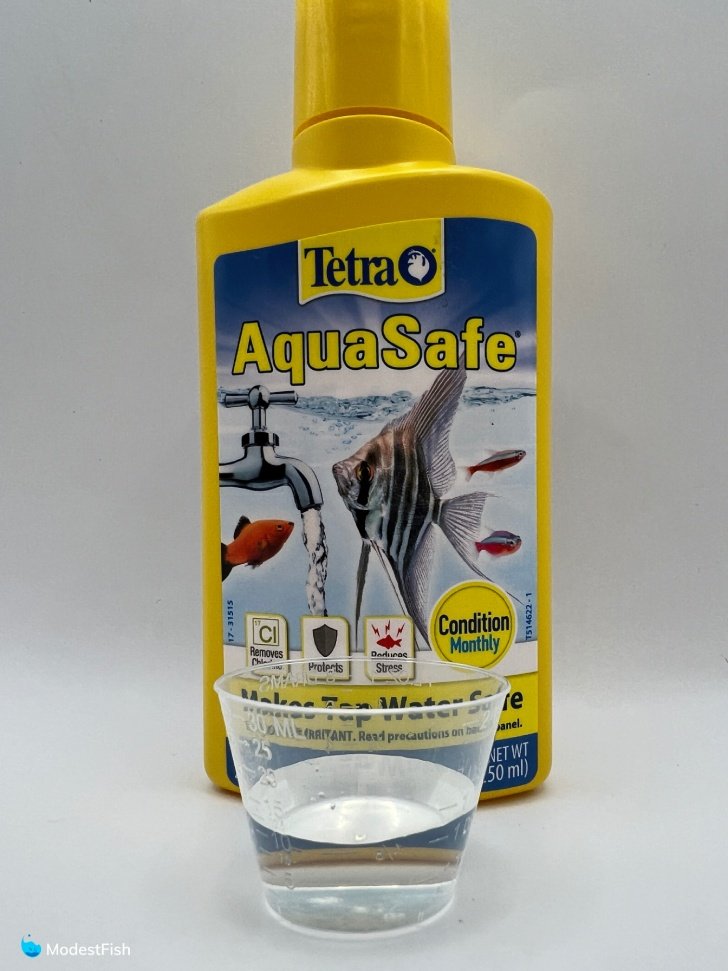
This product is better than nothing, but why go with better than nothing when something totally awesome is available?
It might seem like this product is cheap because the price of a bottle is low, but because a bottle treats so little water, the cost of use for this product is quite high.
What it adds:
AquaSafe doesn’t have any additives that help with slime coat.

Last update on 2024-04-19 / Commissions Earned / Images from Amazon Product Advertising API
Direct Cost Comparison
Now you know more about the individual conditioners, let’s look at a visual representation of the amount required to treat tank water side-by-side.
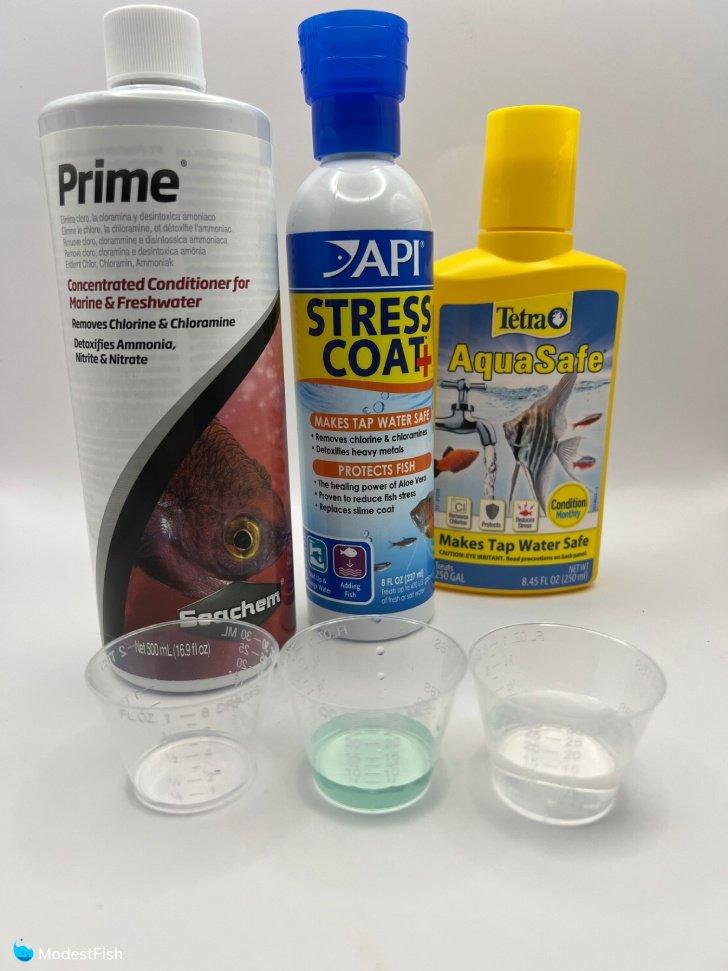
When you look at how much they require per gallon, per 10 gallons, and per 50 gallons, you can clearly see how far Seachem Prime will go in comparison to the others.
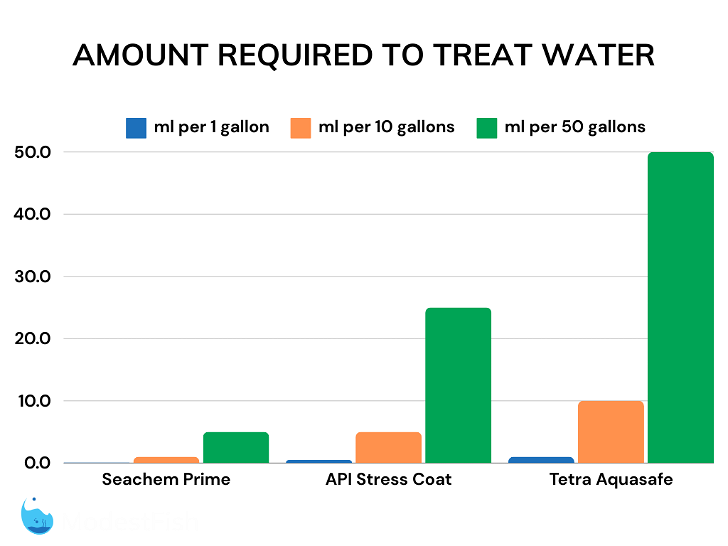
And when you look at how much they’ll treat per 250ml, it’s even more clear as to why Seachem Prime is your best choice:

At an initial glance, Seachem prime may look like it costs more than the others, but you’re actually getting far more water conditioning per dollar spent.
Conclusions
When it comes to dechlorinators, hands down, Seachem Prime is the best deal. It detoxifies the most substances and it’s more concentrated than its competitors.
It’s true that it doesn’t have anything to increase slime coat, but in my opinion, this isn’t something that you need to do all the time anyway.
I do keep a bottle of Stress Coat around in case a fish gets banged up, but I don’t use it as my regular dechlorinator when I do water changes. It’s not necessary.
Prime is a better product and more economical, a total win win situation.
I hope you find this article helpful.
I wish you and your fish the very best!

I loved your review of aquarium water conditioners. It is unfortunate that all the links to products go to Amazon. Their Prime costs over twice as much as Petco, and I haven’t even LOOKED for the cheapest price, that’s just where I usually buy things and I first looked at the price there.
Thank you for such a great analysis and review. Oh, ad Yes, I have been using prime since I got my first tank over 20 years ago! lol